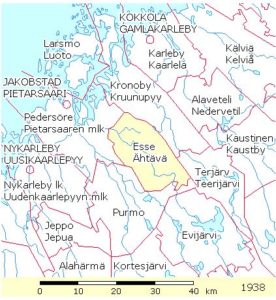By Hjalmar Krokfors from “Den Österbottniska byn”.
Translated by June Pelo

When some special work such as baking, distilling or brewing needed to be done in olden days, the wife rose early in the grey morning. The right time to leave the bed was 5 a.m. The fire was made in the fireplace using as kindling the big high mound of shavings, generally from the previous evening’s work, that had been on the cottage floor. Soon the sparks, like a broom, swept out the dark night. The firelight glimmered from the windows and aperatures.
The well handle bent and dipped deep, balanced itself and the big bucket was filled. The water was then carried to the cattle shed where the hay and grain gave off the scent of new-mown hay. The smoke swirled, and rose through the door opening. Life was seething long before cock-crow and sunrise.
The fire under the copper coffeepot burned calmly and gently. And the covered dough rose with the heat. The small kegs were constructed with care by the old men. In the old village one can look at small kegs so finely wrapped that they resemble the work of a goldsmith rather than that of a carpenter.
In the old village the days had their varied activities. The production of barrels took a long time. Those who tarred the barrels for sale usually worked indoors. But some worked on the barrels in the drying shed. There the staves were piled up for drying behind closed doors while the smoke belched out and, in time, various tools were used. We now look with amazement at those tools in museums. There stood the old man straining his knees and back among the bottomless barrel staves while he used the barrel axe and various planers along with the big bow compass. It was a glorious time when the tar was heated. The woods were full of shouting men and the notes of the meadow curlews were like happy flute players. Father Forsbacka in Nederlappfors who burned the valley, allowed his son Anders to watch after eating a fish meal. His wife cleaned the perch and cooked it. Anders remembered it all his life.
Many think back to the community fellowship with a feeling that something irreplaceable has been lost. They were refreshing with their wooden flasks and packages of food as they set out to the crowded woods or to join teams for haymaking. It was the cavalier who struck the broadest blows. There was the queen who had a smile on her face when the hard workday ended at last. Now the woman chooses one way and the man another way where willpower and ability do not require a decision. Perhaps it is why so many marriages are formed blindly and fall apart when the test comes. Perhaps we would not trade with the old folks. But they were admirable in their dexterity and stamina. Without falling into a romantic dream about their era, one can safely say that the memory it brings gets lost in the increasing industrialization.